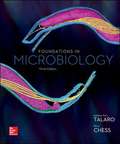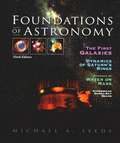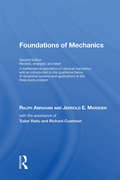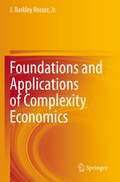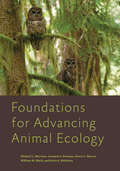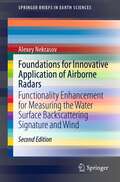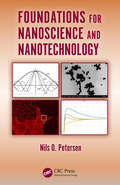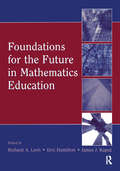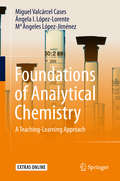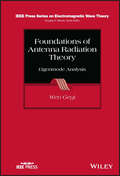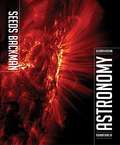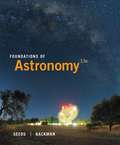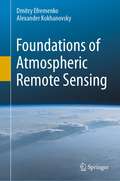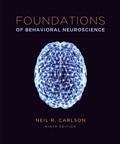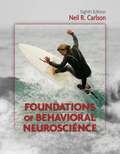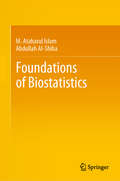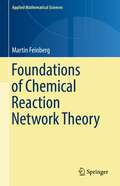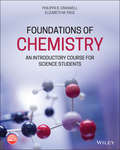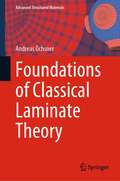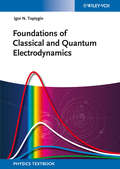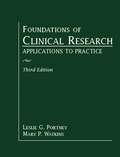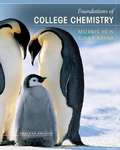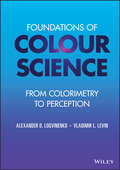- Table View
- List View
Foundations In Microbiology
by Barry Chess Kathleen TalaroWritten with the non-major/allied health student in mind, Foundations in Microbiology offers an engaging and accessible writing style through the use of tools such as case studies and analogies to thoroughly explain difficult microbiology concepts. A taxonomic approach is used for the study of pathogens.
Foundations Of Astronomy
by Michael A. SeedsIn this update of the 2004 edition, an emeritus professor of astronomy in Arizona enthusiastically shares the latest scientific discoveries about the cosmos while emphasizing how scientific arguments are constructed. The introductory text includes visual summaries and color illustrations drawn from NASA and other major sources, exercises utilizing the Web, other problems with a partial answer key, star charts for the Northern and Southern hemispheres, and a glossary. Access to an online resource is available. Unlike the 8th edition, a CD-ROM is not included. Annotation ©2006 Book News, Inc., Portland, OR (booknews.com)
Foundations Of Environmental Engineering
by C. David Cooper John D. Dietz Debra R. ReinhartThe rapidly growing field of environmental engineering is well served by this cogent, up-to-date introduction to the subject. This highly readable volume has three main objectives. The first is to introduce the key concepts of material and energy balances and to make these principles an integral part of the reader s thought processes. The second is to incorporate an interdisciplinary approach in introducing the major topics of environmental engineering in the belief that fore-knowledge of possible environmental consequences will lead to better designs from all engineers. Finally, it provides a strong foundation for further study by environmental engineering majors. In accomplishing these objectives, the authors strike the proper balance between the voluminous and detailed presentation in some texts, and the general and qualitative coverage given in others. Throughout this well-written book, the authors make good use of diagrams, example problems, and end-of-chapter problems to illuminate and reinforce the concepts presented. The concluding chapter offers case studies that further illustrate the foundations presented in the text.
Foundations Of Mechanics
by Ralph AbrahamFoundations of Mechanics is a mathematical exposition of classical mechanics with an introduction to the qualitative theory of dynamical systems and applications to the two-body problem and three-body problem.
Foundations and Applications of Complexity Economics
by J. Barkley Rosser, Jr.This book presents a survey of the aspects of economic complexity, with a focus on foundational, interdisciplinary ideas. The long-awaited follow up to his 2011 volume Complex Evolutionary Dynamics in Urban-Regional and Ecologic-Economic Systems: From Catastrophe to Chaos and Beyond, this volume draws together the threads of Rosser’s earlier work on complexity theory and its wide applications in economics and an expanded list of related disciplines. The book begins with a full account of the broader categories of complexity in economics--dynamic, computational, hierarchical, and structural--before shifting to more detailed analysis. The next two chapters address problems associated with computational complexity, especially those of computability, and discuss the Godel Incompleteness Theorem with a focus on reflexivity. The middle chapters discuss the relationship between entropy, econophysics, evolution, and economic complexity, respectively, with applications in urban and regional dynamics, ecological economics, general equilibrium theory, as well as financial market dynamics. The final chapter works to bring together these themes into a broader framework and expose some of the limits concerning analysis of deeper foundational issues.With applications in all disciplines characterized by interconnected nonlinear adaptive systems, this book is appropriate for graduate students, professors and practitioners in economics and related disciplines such as regional science, mathematics, physics, biology, environmental sciences, philosophy, and psychology.
Foundations for Advancing Animal Ecology (Wildlife Management and Conservation)
by Michael L. Morrison Bruce G. Marcot Leonard A. Brennan William M. Block Kevin S. McKelveyA look at how wildlife professionals can modernize their approaches to habitat and population management with a fresh take on animal ecology.How can we maximize the probability that a species of wild animal will persist into the future? This audacious book proposes that advancing animal ecology—and conservation itself—demands that we reenvision our basic understanding of how animals interact with their environments and with each other. Synthesizing where we are and where we need to go with our studies of animals and their environs, Foundations for Advancing Animal Ecology asserts that studies of animal ecology should begin with a focus on the behaviors and characteristics of individual organisms. The book examines• the limitations of classic approaches to the study of animal ecology• how organisms organize into collections, such as breeding pairs, flocks, and herds• how the broader biotic and abiotic environment shapes animal populations, communities, and ecosystems• factors underlying the distribution and abundance of species through space and time• the links between habitat and population• why communication between researchers and managers is key• specific strategies for managing wild animal populations and habitats in an evolutionary and ecosystem contextThroughout, the authors stress the importance of speaking a common and well-defined language. Avoiding vague and misleading terminology, they argue, will help ecologists translate science into meaningful and lasting actions in the environment. Taking the perspective of the organism of interest in developing concepts and applications, the authors always keep the potentially biased human perspective in focus. A major advancement in understanding the factors underlying wildlife-habitat relationships, Foundations for Advancing Animal Ecology will be an invaluable resource to professionals and practitioners in natural resource management in public and private sectors, including state and federal agencies, non-governmental organizations, and environmental consultants.
Foundations for Innovative Application of Airborne Radars: Functionality Enhancement for Measuring the Water Surface Backscattering Signature and Wind (SpringerBriefs in Earth Sciences)
by Alexey NekrasovThis book discusses methods for measuring the water surface backscattering signature and estimating the near-surface wind vector over water using airborne radars, in addition to their standard application. Airborne FMCW demonstrator system, Doppler navigation system, airborne weather radar, airborne radar altimeter, and airborne precipitation radar are analyzed in order to be used for that purpose. The radars functionality is enhanced for their operation in a scatterometer mode. A circle flight and/or a rectilinear flight of an aircraft over the water surface is considered depending on the radar design features to perform measurements of the azimuth normalized radar cross section curve of the water surface and/or the near-surface wind speed and direction. Flight recommendations to perform measurements along with algorithms for measuring the water surface backscattering signature and for retrieval of the wind speed and direction over water are presented.
Foundations for Nanoscience and Nanotechnology
by Nils O. PetersenDo you ever wonder why size is so important at the scale of nanosystems? Do you want to understand the fundamental principles that govern the properties of nanomaterials? Do you want to establish a foundation for working in the field of nanoscience and nanotechnology? Then this book is written with you in mind. Foundations for Nanoscience and Nanotechnology provides some of the physical chemistry needed to understand why properties of small systems differ both from their constituent molecular entities and from the corresponding bulk matter. This is not a book about nanoscience and nanotechnology, but rather an exposition of basic knowledge required to understand these fields. The collection of topics makes it unique, and these topics include: The concept of quantum confinement and its consequences for electronic behaviour (Part II) The importance of surface thermodynamics for activity and interactions of nanoscale systems (Part III) The need to consider fluctuations as well as mean properties in small systems (Part IV) The interaction of light with matter and specific applications of spectroscopy and microscopy (Part V) This book is written for senior undergraduates or junior graduate students in science or engineering disciplines who wish to learn about or work in the areas of nanoscience and nanotechnology, but who do not have the requisite background in chemistry or physics. It may also be useful as a refresher or summary text for chemistry and physics students since the material is focused on those aspects of quantum mechanics, thermodynamics, and statistical mechanics that specifically relate to the size of objects.
Foundations for Physical Science (Third Edition)
by Tom HsuThis popular Physical Science program includes exciting new graphics and features. The new full color student book provides even more ways to help students to access science concepts; the Investigation Manual Labs include an addition level of difficulty. The third edition also offers students more practice and assessment and more connections to technology and the real world.
Foundations for the Future in Mathematics Education
by Richard A. Lesh; Eric Hamilton; James J. KaputThe central question addressed in Foundations for the Future in Mathematics Education is this: What kind of understandings and abilities should be emphasized to decrease mismatches between the narrow band of mathematical understandings and abilities that are emphasized in mathematics classrooms and tests, and those that are needed for success beyond school in the 21st century? This is an urgent question. In fields ranging from aeronautical engineering to agriculture, and from biotechnologies to business administration, outside advisors to future-oriented university programs increasingly emphasize the fact that, beyond school, the nature of problem-solving activities has changed dramatically during the past twenty years, as powerful tools for computation, conceptualization, and communication have led to fundamental changes in the levels and types of mathematical understandings and abilities that are needed for success in such fields. For K-12 students and teachers, questions about the changing nature of mathematics (and mathematical thinking beyond school) might be rephrased to ask: If the goal is to create a mathematics curriculum that will be adequate to prepare students for informed citizenship—as well as preparing them for career opportunities in learning organizations, in knowledge economies, in an age of increasing globalization—how should traditional conceptions of the 3Rs be extended or reconceived? Overall, this book suggests that it is not enough to simply make incremental changes in the existing curriculum whose traditions developed out of the needs of industrial societies. The authors, beyond simply stating conclusions from their research, use results from it to describe promising directions for a research agenda related to this question. The volume is organized in three sections: *Part I focuses on naturalistic observations aimed at clarifying what kind of “mathematical thinking” people really do when they are engaged in “real life” problem solving or decision making situations beyond school. *Part II shifts attention toward changes that have occurred in kinds of elementary-but-powerful mathematical concepts, topics, and tools that have evolved recently—and that could replace past notions of “basics” by providing new foundations for the future. This section also initiates discussions about what it means to “understand” the preceding ideas and abilities. *Part III extends these discussions about meaning and understanding—and emphasizes teaching experiments aimed at investigating how instructional activities can be designed to facilitate the development of the preceding ideas and abilities. Foundations for the Future in Mathematics Education is an essential reference for researchers, curriculum developers, assessment experts, and teacher educators across the fields of mathematics and science education.
Foundations of Analytical Chemistry
by Miguel Valcárcel Cases Ángela I. López-Lorente Ma Ángeles López-JiménezThis book offers a completely new approach to learning and teaching the fundamentals of analytical chemistry. It summarizes 250 basic concepts of the field on the basis of slides. Each of the nine chapters offers the following features:• Introduction: Summary. General scheme. Teaching objectives.• Text containing the explanation of each slide.• Recommended and commented bibliography.• Questions to be answered.• Slides. A distinct feature of this novel book is its focus on the fundamental concepts and essential principles of analytical chemistry, which sets it apart from other books presenting descriptive overviews of methods and techniques.
Foundations of Antenna Radiation Theory: Eigenmode Analysis (IEEE Press Series on Electromagnetic Wave Theory)
by Wen GeyiFoundations of Antenna Radiation Theory Understand the theory and function of wireless antennas with this comprehensive guide As wireless technology continues to develop, understanding of antenna properties and performance will only become more critical. Since antennas can be understood as junctions of waveguides, eigenmode analysis—the foundation of waveguide theory, concerned with the unexcited states of systems and their natural resonant characteristics—promises to be a crucial frontier in the study of antenna theory. Foundations of Antenna Radiation Theory incorporates the modal analysis, generic antenna properties and design methods discovered or developed in the last few decades, not being reflected in most antenna books, into a comprehensive introduction to the theory of antennas. This book puts readers into conversation with the latest research and situates students and researchers at the cutting edge of an important field of wireless technology. The book also includes: Detailed discussions of the solution methods for Maxwell equations and wave equations to provide a theoretical foundation for electromagnetic analysis of antennas Recent developments for antenna radiation in closed and open space, modal analysis and field expansions, dyadic Green’s functions, time-domain theory, state-of-the-art antenna array synthesis methods, wireless power transmission systems, and more Innovative material derived from the author’s own research Foundations of Antenna Radiation Theory is ideal for graduate or advanced undergraduate students studying antenna theory, as well as for reference by researchers, engineers, and industry professionals in the areas of wireless technology.
Foundations of Astronomy
by Michael A. Seeds Dana E. BackmanCompletely current with the newest developments from the field, FOUNDATIONS OF ASTRONOMY, 11e helps readers use astronomy to understand science--and use science to understand what we are. Fascinating and engaging, this text helps you answer two fundamental questions: What are we? And how do we know? This edition addresses the latest discoveries in the exciting study of astronomy, including information to emphasize observations over the entire electromagnetic spectrum; new data on star formation and stellar structure; new insight on global warming and ozone depletion; updated information on the Kuiper belt and dwarf planets; and much more.
Foundations of Astronomy
by Michael A. Seeds Dana E. BackmanFascinating, engaging, and extremely visual, FOUNDATIONS OF ASTRONOMY, Thirteenth Edition, is renowned for its current coverage, reader-friendly presentation, and detailed, yet clear explanations. The authors' goals are to help you use astronomy to understand science--and use science to answer two fundamental questions: What are we? And how do we know?
Foundations of Atmospheric Remote Sensing
by Dmitry Efremenko Alexander KokhanovskyTheoretical foundations of atmospheric remote sensing are electromagnetic theory, radiative transfer and inversion theory. This book provides an overview of these topics in a common context, compile the results of recent research, as well as fill the gaps, where needed. The following aspects are covered: principles of remote sensing, the atmospheric physics, foundations of the radiative transfer theory, electromagnetic absorption, scattering and propagation, review of computational techniques in radiative transfer, retrieval techniques as well as regularization principles of inversion theory. As such, the book provides a valuable resource for those who work with remote sensing data and want to get a broad view of theoretical foundations of atmospheric remote sensing. The book will be also useful for students and researchers working in such diverse fields like inverse problems, atmospheric physics, electromagnetic theory, and radiative transfer.
Foundations of Behavioral Neuroscience
by Neil R. CarlsonThe ninth edition of Foundations of Behavioral Neuroscience offers a concise introduction to behavioral neuroscience. The text incorporates the latest studies and research in the rapidly changing fields of neuroscience and physiological psychology. The theme of strategies of learning helps readers apply these research findings to daily life. Foundations of Behavioral Neuroscience is an ideal choice for the instructor who wants a concise text with a good balance of human and animal studies.
Foundations of Behavioral Neuroscience (Eighth Edition)
by Neil R. Carlson'Foundations of Behavioral Neuroscience' offers a briefer, sixteen chapter introduction to the foundations of physiology, incorporating the latest studies and research in the rapidly changing fields of neuroscience and physiological psychology.
Foundations of Biostatistics
by M. Ataharul Islam Abdullah Al-ShihaThis book offers a comprehensive guide to essential techniques and methods in biostatistics, addressing the underlying concepts to aid in comprehension. The use of biostatistics techniques has increased manifold in the recent past, due to their suitability for applications in a wide range of problems in various fields. This book helps learners grasp the materials in detail, equipping them to use biostatistics techniques independently and confidently. The book starts with a summary of background materials, followed by methods and techniques. As such, with only minimum guidance from teachers, this book can provide materials for self-learning of biostatistics techniques with a deeper level of understanding. The first two chapters focus on fundamental concepts, sources of data, data types, organization of data, and descriptive statistics, followed by the basic probability concepts, distributions and sampling distributions needed in order to combine descriptive statistics with inferential techniques. Estimation and tests of hypotheses are illustrated in two separate chapters. Important measures of association, linear regression, analysis of variance and logistic regression, and proportional hazards models are then presented systematically, ensuring that the book covers the topics most essential to students and users of biostatistics in connection with a wide range of applications in various fields. The book has been carefully structured, and the content is presented in a sequence covering the essential background in a highly systematic manner, supporting the learning process by presenting theory and applications that complement one another.
Foundations of Chemical Reaction Network Theory (Applied Mathematical Sciences #202)
by Martin FeinbergThis book provides an authoritative introduction to the rapidly growing field of chemical reaction network theory. In particular, the book presents deep and surprising theorems that relate the graphical and algebraic structure of a reaction network to qualitative properties of the intricate system of nonlinear differential equations that the network induces. Over the course of three main parts, Feinberg provides a gradual transition from a tutorial on the basics of reaction network theory, to a survey of some of its principal theorems, and, finally, to a discussion of the theory’s more technical aspects. Written with great clarity, this book will be of value to mathematicians and to mathematically-inclined biologists, chemists, physicists, and engineers who want to contribute to chemical reaction network theory or make use of its powerful results.
Foundations of Chemistry: An Introductory Course for Science Students
by Philippa B. Cranwell Elizabeth M. PageFOUNDATIONS OF CHEMISTRY A foundation-level guide to chemistry for physical, life sciences and engineering students Foundations of Chemistry: An Introductory Course for Science Students fills a gap in the literature to provide a basic chemistry text aimed at physical sciences, life sciences and engineering students. The authors, noted experts on the topic, offer concise explanations of chemistry theory and the principles that are typically reviewed in most one year foundation chemistry courses and first year degree-level chemistry courses for non-chemists. The authors also include illustrative examples and information on the most recent applications in the field. Foundations of Chemistry is an important text that outlines the basic principles in each area of chemistry - physical, inorganic and organic - building on prior knowledge to quickly expand and develop a student's knowledge and understanding. Key features include: Worked examples showcase core concepts and practice questions. Margin comments signpost students to knowledge covered elsewhere and are used to highlight key learning objectives. Chapter summaries list the main concepts and learning points.
Foundations of Classical Laminate Theory (Advanced Structured Materials #163)
by Andreas ÖchsnerThis book provides a systematic and thorough introduction to the classical laminate theory based on the theory for plane elasticity elements and classical (shear–rigid) plate elements. It focus on unidirectional lamina which can be described based on orthotropic constitutive equations and their composition to layered laminates. In addition to the elastic behavior, failure is investigated based on the maximum stress, maximum strain, Tsai–Hill and the Tsai–Wu criteria.
Foundations of Classical and Quantum Electrodynamics
by Igor N. ToptyginThis advanced textbook covers many fundamental, traditional and new branches of electrodynamics, as well as the related fields of special relativity, quantum mechanics and quantum electrodynamics. The book introduces the material at different levels, oriented towards 3rd-4th year bachelor, master, and PhD students. This is so as to describe the whole complexity of physical phenomena, instead of a mosaic of disconnected data. The required mathematical background is collated in Chapter 1, while the necessary physical background is included in the main text of the corresponding chapters and also given in appendices.The content is based on teaching material tested on students over many years, and their training to apply general theory for solving scientific and engineering problems. To this aim, the book contains approximately 800 examples and problems, many of which are described in detail. Some of these problems are designed for students to work on their own with only the answers and descriptions of results, and may be solved selectively. The examples are key ingredients to the theoretical course; the user should study all of them while reading the corresponding chapters. Equally suitable as a reference for researchers specialized in science and engineering.
Foundations of Clinical Research: Applications to Practice (3rd Edition)
by Leslie G. Portney Mary P. WatkinsBook intended for medical students, residents, fellows and research nurses pursuing clinical research, which covers the basics - logic and thinking , growing emphasis on Evidence Based Practice (EBP), systematic reviews, meta-analysis etc.
Foundations of College Chemistry
by Morris Hein Susan ArenaLearning the fundamentals of chemistry can be a difficult task to undertake. The market leader for 35 years, Foundations of College Chemistry has helped countless readers master the chemistry skills they need to succeed. The book is known for its accuracy and direct writing style. Hein follows a step-by-step approach to problem solving with alternate methods of solution when appropriate. The new 12th edition has also been updated throughout with the latest information in the field.
Foundations of Colour Science: From Colorimetry to Perception
by Alexander D. Logvinenko Vladimir L. LevinPresents the science of colour from new perspectives and outlines results obtained from the authors&’ work in the mathematical theory of colour This innovative volume summarizes existing knowledge in the field, attempting to present as much data as possible about colour, accumulated in various branches of science (physics, phychophysics, colorimetry, physiology) from a unified theoretical position. Written by a colour specialist and a professional mathematician, the book offers a new theoretical framework based on functional analysis and convex analysis. Employing these branches of mathematics, instead of more conventional linear algebra, allows them to provide the knowledge required for developing techniques to measure colour appearance to the standards adopted in colorimetric measurements. The authors describe the mathematics in a language that is understandable for colour specialists and include a detailed overview of all chapters to help readers not familiar with colour science. Divided into two parts, the book first covers various key aspects of light colour, such as colour stimulus space, colour mechanisms, colour detection and discrimination, light-colour perception typology, and light metamerism. The second part focuses on object colour, featuring detailed coverage of object-colour perception in single- and multiple-illuminant scenes, object-colour solid, colour constancy, metamer mismatching, object-colour indeterminacy and more. Throughout the book, the authors combine differential geometry and topology with the scientific principles on which colour measurement and specification are currently based and applied in industrial applications. Presents a unique compilation of the author&’s substantial contributions to colour science Offers a new approach to colour perception and measurement, developing the theoretical framework used in colorimetry Bridges the gap between colour engineering and a coherent mathematical theory of colour Outlines mathematical foundations applicable to the colour vision of humans and animals as well as technologies equipped with artificial photosensors Contains algorithms for solving various problems in colour science, such as the mathematical problem of describing metameric lights Formulates all results to be accessible to non-mathematicians and colour specialistsFoundations of Colour Science: From Colorimetry to Perception is an invaluable resource for academics, researchers, industry professionals and undergraduate and graduate students with interest in a mathematical approach to the science of colour.
